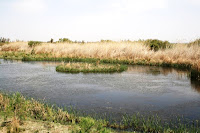It doesn’t take many miles east of Amman before you realize the guide book nailed it: a flat featureless desert that covers 80% of the country and is home to 5% of the population. Our sortie towards the Iraq border was in order to visit RSCN’s Azraq Nature/Wetlands Preserve. Like other RSCN Reserve’s there is investment in socio-economics (something I’ve called “social capitalism” since the early 70’s). They employ local artisans in making painted ostrich eggs, eco-board games & puzzles, recycled paper, textiles, packaging, etc.
The Reserve is a fraction of the former wetlands, as it was pumped dry in the early 90’s in order to provide water to Amman’s sprawl (many Palestinian refugees) and agriculture. On bird count day in 1967 over 340,000 birds were counted; by 1991 it was 1,200. RSCN has helped to rehabilitate 10% of the wetlands: some birds and water buffalo are back.
The drive south through miles and miles of flat desert-varnished terrain reminded me of the sea when it is like glass (only its antithesis due to the dryness of it all: figured “no way cold a desert tortoise survive here”). As I drove, I thought about our last two dive trips (Isla Marisol, Belize; Taveuni, Fiji), with a smile towards the approaching clouds of dust & sand. A good thing about the rocky portions of the landscape is that it least keeps some of the sands in place for a while. Just so you know, it is possible to get rain during a dust & sand storm, and yes, you do get a nice muddy slime on the window. We arrived back in Wadi Musa in early evening. Tomorrow marks 4-weeks that we’ve been in Jordan. We’ll be doing something that has been very rare: taking the day-off. Probably for some reflection time we hope that the government of the USA passes a budget or continuing resolution [inshallah], so we can remain here working with Park Rangers (though we’re retired from NPS, our travel here is paid by the Dept. of Interior ). Have a great day…


I wonder if these wetlands are the same ones that at one time continued into Iraq and were cited by Rory Stewart, (Scotsman adventurer and JFK School of Gov Fellow) in his book, Prince of the Marshes. Those marshs were drained by Sadam in an effort to remove cover for hiding dissidents.
ReplyDeleteRandy Crutcher
Randy.....different marshes in a completely different area. the marshes you mention are at the junction of the Tigris and Euphrates Rivers.
ReplyDeletePhil....I wanted to cry when I visited Azraq......unbelievable to see the destruction of a vast wetland with a great history......The refugees from the Cacaus mountains settled in this area